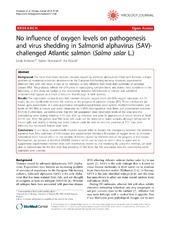| dc.description.abstract | Background For more than three decades, diseases caused by salmonid alphaviruses (SAV) have become a major problem of increasing economic importance in the European fish-farming industry. However, experimental infection trials with SAV result in low or no mortality i.e very different from most field outbreaks of pancreas disease (PD). This probably reflects the difficulties in reproducing complex biotic and abiotic field conditions in the laboratory. In this study we looked at the relationship between SAV-infection in salmon and sub-lethal environmental hypoxia as a result of reduced flow-through in tank systems. Results The experiment demonstrated that constant reduced oxygen levels (60-65% oxygen saturation: 6.5-7.0 mg/L) did not significantly increase the severity or the progress of pancreas disease (PD). These conclusions are based upon assessments of a semi-quantitative histopathological lesion score system, morbidities/mortalities, and levels of SAV RNA in tissues and water (measured by 1 MDS electropositive virus filters and downstream real-time RT-PCR). Furthermore, we demonstrate that the fish population shed detectable levels of the virus into the surrounding water during viraemia; 4-13 days after i.p. infection, and prior to appearance of severe lesions in heart (21-35 dpi). After this period, viral RNA from SAV could not be detected in water samples although still present in tissues (gills and hearts) at lasting low levels. Lesions could be seen in exocrine pancreas at 7-21 days post infection, but no muscle lesions were seen. Conclusions In our study, experimentally induced hypoxia failed to explain the discrepancy between the severities reported from field outbreaks of SAV-disease and experimental infections. Reduction of oxygen levels to constant suboptimal levels had no effect on the severity of lesions caused by SAV-infection or the progress of the disease. Furthermore, we present a modified VIRADEL method which can be used to detect virus in water and to supplement experimental infection trials with information related to viral shedding. By using this method, we were able to demonstrate for the first time that shedding of SAV from the fish population into the surrounding water coincides with viraemia. | en_US |

